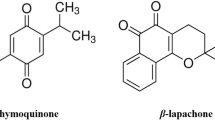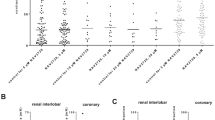Summary
Effects of glyceryl trinitrate (GTN) and nitric oxide (NO) on the cardiac functions and myocardial cyclic GMP (cGMP) contents were examined in comparison with those in the aorta and correlated with myoglobin (an inhibitor of soluble guanylate cyclase) contents using the preparations isolated from the reserpinized rabbit.
GTN (10−10-10−4mol/l) produced a dose-dependent relaxation in the aorta. However, this compound exerted no effect on the rate of the spontaneous beat of the right atrium and the contraction of the papillary muscle. A transient and significant increase in cGMP was observed in the aorta with GTN (3 × 10−6 mol/l). Although the increase was also observed in the right atrium, it was much smaller. No definite change was observed in papillary muscle. Increases in cGMP produced by NO (3 × 10−6 mol/l) were larger and significant in all tissues; (AUCcGMP(GTN)/AUCcGMP(NO)) ratio was 30.1 for the aorta, 65.0 for the right atrium and 16.3% for the papillary muscle. Although higher concentrations of NO were necessary in the right atrium and papillary muscle to induce increases in cGMP, no differences were noted in the three tissues as regards the maximum accumulation of this substance. Furthermore, kinetic analysis of NO-induced increases in tissue cGMP indicated no marked difference in the production rate among the three tissues, while the rate of elimination of cGMP was lower in the aorta than in the atrium or the papillary muscle. The increases in cGMP observed in these three tissues were inversely related to the contents of myoglobin in respective tissues. No effect on myocardial function was observed with NO up to the concentration of 3 × 10−5 mol/l.
These results suggest that myoglobin, an endogenous inhibitor of activation of soluble guanylate cyclase by NO, was responsible for the lower production of cGMP by NO and GTN in the myocardial tissue.
Similar content being viewed by others
References
Ahlner J, Andersson RG, Torfgård K, Axelsson KL (1991) Organic nitrate esters: clinical use and mechanisms of actions. Pharmacol Rev 43:351–423
Arnold WP, Mittal CK, Katsuki S, Murad F (1977) Nitric oxide activates guanylate cyclase and increases guanosine 3′:5′-cyclic monophosphate levels in various tissue preparations. Proc Natl Acad Sci USA 74:3203–3207
Axelsson KL, Wikberg JE, Andersson RG (1979) Relationship between nitroglycerin, cyclic GMP and relaxation of vascular smooth muscle. Life Sci 24:1779–1786
Bailey JR, Sephton DH, Driedzic WR (1990) Oxygen uptake by isolated perfused fish hearts with differing myoglobin concentrations under hypoxic conditions. J Mol Cell Cardiol 22:1125–1134
Bennett BM, Kobus SM, Brien JF, Nakatsu K, Marks GS (1986) Requirement for reduced, unliganded hemoprotein for the hemoglobin-and myoglobin-mediated biotransformation of glyceryl trinitrate. J Pharmacol Exp Ther 237:629–635
Blinks JR, Koch-Weser J (1963) Physiological factors in the analysis of the actions of drugs on myocardial contractility. Pharmacol Rev 15:531–599
Brien JF, McLaughlin BE, Breedon TH, Bennett BM, Nakatsu K, Marks GS (1986) Biotransformation of glyceryl trinitrate occurs concurrently with relaxation of rabbit aorta. J Pharmacol Exp Ther 237:608–614
Diamond J, Ten Eick RE, Trapani AJ (1977) Are increases in cyclic GMP levels responsible for the negative inotropic effects of acetylcholine in the heart? Biochem Biophys Res Commun 79:912–918
Doyle MP, Hoekstra J (1981) Oxidation of nitrogen oxides by bound dioxygen in hemoproteins. J Inorg Biochem 14:351–358
Endoh M, Yamashita S (1981) Differential responses to carbachol, sodium nitroprusside and 8-bromo-guanosine 3′,5′-monophosphate of canine atrial and ventricular muscle. Br J Pharmacol 73:393–399
Enoki Y, Morimoto T, Nakatani A, Sakata S, Ohga Y, Kohzuki H, Shimizu S (1988) Wide variation of myoglobin contents in gizzard smooth muscles of various avian species. Adv Exp Med Biol 222:709–716
Feelisch M, Noack EA (1987) Correlation between nitric oxide formation during degradation of organic nitrates and activation of guanylate cyclase. Eur J Pharmacol 139:19–30
Feelisch M, Noack E, Schroder H (1988) Explanation of the discrepancy between the degree of organic nitrate decomposition, nitrite formation and guanylate cyclase stimulation. Eur Heart J 9 [Suppl]A: 57–62
Fung H-L, Chung SJ, Chung S, Hough K, Kakami M, Kowaluk E (1989) Cellular mechanism of nitrate action. Z Kardiol 78 [Suppl 2]: 14–17
Galaris D, Eddy L, Arduini A, Cadenas E, Hochstein P (1989) Mechanisms of reoxygenation injury in myocardial infarction: implications of a myoglobin redox cycle. Biochem Biophys Res Commun 160:1162–1168
Gerzer R, Bohme E, Hofmann F, Schultz G (1981) Soluble guanylate cyclase purified from bovine lung contains heme and copper. FEBS Lett 132:71–74
Gerzer R, Radany EW, Garbers DL (1982) The separation of the heme and apoheme forms of soluble guanylate cyclase. Biochem Biophys Res Commun 108:678–686
Goetz KL (1988) Physiology and pathophysiology of atrial peptides. Am J Physiol 254:E1–15
Hamaguchi M, Ishibashi T, Imai S (1992) Involvement of charybdotoxin-sensitive K+ channel in the relaxation of bovine tracheal smooth muscle by glyceryl trinitrate and sodium nitroprusside. J Pharmacol Exp Ther 262:263–270
Hansen RS, Beavo JA (1982) Purification of two calcium/calmodulin-dependent forms of cyclic nucleotide phosphodiesterase by using conformation-specific monoclonal antibody chromatography. Proc Natl Acad Sci USA 79:2788–2792
Ignarro LJ (1991 a) Signal transduction mechanisms involving nitric oxide. Biochem Pharmacol 41:485–490
Ignarro LJ (1991 b) Heme-dependent activation of guanylate cyclase by nitric oxide: A novel signal transduction mechanism. Blood Vessels 28:67–73
Ignarro LJ, Adams JB, Horwitz PM, Wood KS (1986) Activation of soluble guanylate cyclase by NO-hemoproteins involves NO-heme exchange. J Biol Chem 261:4997–5002
Ishibashi T, Hamaguchi M, Imai S (1991) 2-Nicotinamidoethyl acetate (SG-209) is a potassium channel opener: Structure activity relationship among nicorandil derivatives. Naunyn-Schmiedeberg's Arch Pharmacol 334:235–239
Ishibashi T, Hamaguchi M, Imai S (1992) Vasodilating properties of KRN2391: structural basis of a new pyridine-type potassium channel opener with a nitrate moiety. Naunyn-Schmiedeberg's Arch Pharmacol 346:94–101
Katsuki S, Aarnold WP, Murad F (1977) Effects of sodium nitroprusside, nitroglycerin, and sodium azide on levels of cyclic nucleotides and mechanical activity of various tissues. J Cyclic Nucleotide Res 3:239–247
Keravis TM, Wells JN, Hardman JG (1980) Cyclic nucleotide phosphodiesterase activities from pig coronary arteries. Lack of interconvertibility of major forms. Biochim Biophys Acta 613:116–129
Kimura H, Mittal CK, Murad F (1975) Activation of guanylate cyclase from rat liver and other tissues by sodium azide. J Biol Chem 250:8016–8022
Kukovetz WR, Holzmann S, Wurm A, Pöch G (1979) Evidence for cyclic GMP-mediated relaxant effects of nitro-compounds in coronary smooth muscle. Naunyn-Schmiedeberg's Arch Pharmacol 310: 129–138
Laustiola K, Vuorinen P, Vapaatalo H, Metsa Ketela T (1983) Sodium nitroprusside inhibits lactate formation in rat atria: is cyclic GMP involved? Acta Pharmacol Toxicol Copenh 52:195–200
Lincoln TM (1989) Cyclic GMP and mechanism of vasodilation. Pharmac Ther 41:479–502
Lincoln TM, Keely SL (1980) Effects of acetylcholine and nitroprusside on cGMP-dependent protein kinase in the perfused rat heart. J Cyclic Nucleotide Res 6:83–91
Marks GS, Nakatsu K, McLaughlin B, Kawmoto J, Slack C, Brien JF (1989) The role of nitric oxide formation in organic nitrate-induced vasodilation and organic nitrate tolerance. Z Kardiol 78 [Suppl 2]: 18–21
Martin W, Villani GM, Jothianandan D, Furchgott RF (1985) Blockade of endothelium-dependent and glyceryl trinitrate-induced relaxation of rabbit aorta by certain ferrous hemoproteins. J Pharmacol Exp Ther 233:679–685
Méry P-F, Lohmann SM, Walter U, Fischmeister R (1991) Ca2+ current is regulated by cyclic GMP-dependent protein kinase in mammalian cardiac myocytes. Proc Natl Acad Sci USA 88:1197–1201
Mittal CK, Arnold WP, Murad F (1978) Characterization of protein inhibitors of guanylate cyclase activation from rat heart and bovine lung. J Biol Chem 253:1266–1271
Moncada S, Palmer RMJ, Higgs EA (1991) Nitric oxide: Physiology, pathophysiology, and pharmacology. Pharmacol Rev 43:109–142
Murad F, Mittal CK, Arnold WP, Katsuki S, Kimura H (1978) Guanylate cyclase: activation by azide, nitro compounds, nitric oxide, and hydroxyl radical and inhibition by hemoglobin and myoglobin. Adv Cyclic Nucleotide Res 9:145–158
Nichols JW, Weber LJ (1989) Oxidation of cardiac myoglobin in vivo by sodium nitrite or hydroxylamine. Arch Toxicol 63:484–488
Nichols JW, Weber LJ (1990) Lack of myoglobin function in the isolated perfused buffalo sculpin (Enophrys bison) heart. Can J Zool 68:825–829
Reynafarje B (1963) Simplified method for the determination of myoglobin. J Lab Clin Med 61:138–145
Shanahan MF, Edwards BM (1989) Stimulation of glucose transport in rat cardiac myocytes by guanosine 3′,5′-monophosphate. Endocrinology 125:1074–1081
Shikano K, Long CJ, Ohlstein EH, Berkowitz BA (1988) Comparative pharmacology of endothelium-derived relaxing factor and nitric oxide. J Pharmacol Exp Ther 247:873–881
Stuehr DJ, Nathan CF (1989) Nitric oxide. A macrophage product responsible for cytostasis and respiratory inhibition in tumor target cells. J Exp Med 169:1543–1555
Taylor DJ, Matthews PM, Radda GK (1986) Myoglobin-dependent oxidative metabolism in the hypoxic rat heart. Respir Physiol 63: 275–283
Tohse N, Sperelakis N (1991) cGMP inhibits the activity of single calcium channels in embryonic chick heart cells. Circ Res 69:325–331
Waldman SA, Murad F (1987) Cyclic GMP synthesis and function. Pharmacol Rev 39:163–196
Wittenberg JB (1970) Myoglobin-facilitated oxygen diffusion: Role of myoglobin in oxygen entry into muscle. Physiol Rev 50:559–636
Yanagisawa T, Hashimoto H, Taira N (1988) The negative inotropic effect of nicorandil is independent of cyclic GMP changes: a comparison with pinacidil and cromakalim in canine atrial muscle. Br J Pharmacol 95:393–398
Author information
Authors and Affiliations
Additional information
Correspondence to T. Ishibashi at the above address
Rights and permissions
About this article
Cite this article
Ishibashi, T., Hamaguchi, M., Kato, K. et al. Relationship between myoglobin contents and increases in cyclic GMP produced by glyceryl trinitrate and nitric oxide in rabbit aorta, right atrium and papillary muscle. Naunyn-Schmiedeberg's Arch Pharmacol 347, 553–561 (1993). https://doi.org/10.1007/BF00166750
Received:
Accepted:
Issue Date:
DOI: https://doi.org/10.1007/BF00166750




